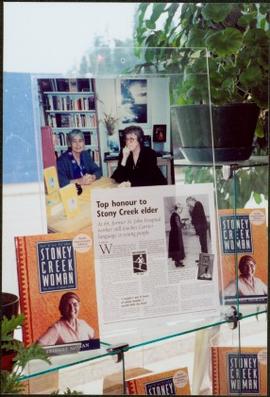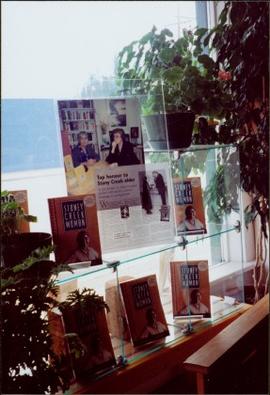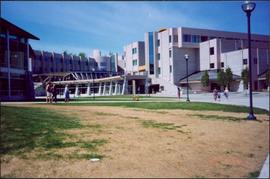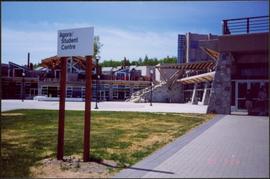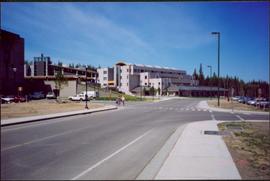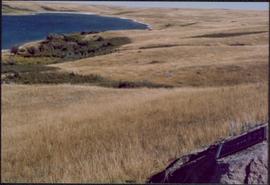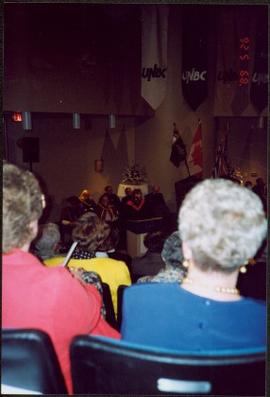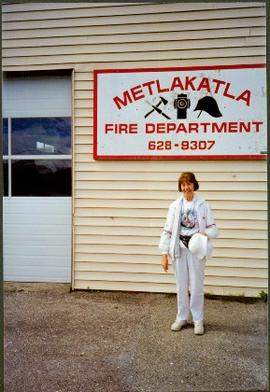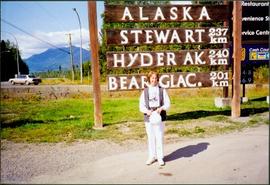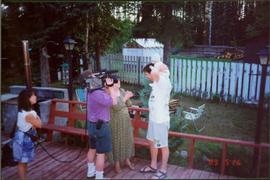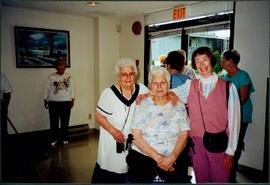File consists of Yinka Dene [Language Institute]: Letter to Brian Lam, Arsenal Pulp Press from Bridget Moran re: inclusion of excerpts from Stoney Creek Woman into a publication by the Yinka Dene Language Institute entitled "Mary Goes to Lejac" (Feb. 7, 1998), Activity Report to Yinka Dene Board of Directors, and Yinka Dene Language Institute's Board of Director's Meeting Board Kit (Feb. 6, 1998).
File consists of:
- Newspaper clippings from The Citizen.
- Letter from Betty Edwards to Bridget Moran re: publishing efforts (March 25, 1997)
- Letter from Brendan Gullen (?) to Bridget Moran re: writing (March 28, 1997)
- Handout (?) entitled "Punctuation" based on Edward P.J. Corbett's book The Little English Handbook: Choices and Conventions.
- Curriculum Vitae of Larissa Lai [RESTRICTED]
- Brochure for Valley View Bed and Breakfast.
File consists of a notebook containing: addresses, names, phone numbers, teaching notes and records from Writing Workshop, Wells, B.C. - schedules, writing assignments, section copy of "On Writing Well" by William Zinsser, "The Ten Commandments for a Writer", "Writer's Block" from Anybody Can Write.
File consists of:
- Brochure for Canadian Books in Print
- Address label for National Library of Canada, Canadiana Acquisitions Division and Legal Deposit Office
- Letter from John Colombo to Bridget Moran re: suggestions for reprinting of Prince George Remembered
- National Library of Canada form: Publication for listing in Canadiana - Canada's National Bibliography
- Advertisement re: Free listings in Quill & Quire's 1996 fall announcements and Canadian Books in Print 1996
- 2 copies of Canadian Books in Print Title Entry Form / Quill & Quire's Fall 1996 Announcement Form
- Moran, Bridget. Prince George Remembered. Prince George: Moran Publishing, 1996 (3rd printing)
- Catalogue of new books from Colombo & Company.
File consists of:
- Annotated transcript of interview with Justa Monk
- [Chapter?] "Eight" of Justa edited by Mayo Moran
- [Chapter?] "Eight" of Justa edited by Roseanne Moran
- [Chapter?] "Eight" of Justa edited by unidentified individual
- [Chapter?] "Eight" of Justa edited by Linda
- Maupassant, Guy de. The Necklace. London: Phoenix, 1996.
File consists of:
- "O ye dry bones: the Prince George orthopedic exodus" by Bridget Moran (Current, Feb.-Mar. 1996)
- "New Prince George jail can't solve old problem" by Bridget Moran (Current, Oct.1994)
- "Let's stop slandering welfare recipients" by Bridget Moran, (The Vancouver Sun, July 29, 1993)
- "The grief of giving up my long-time comfort" by Bridget Moran (The Vancouver Sun, Feb. 22, 1992).
Photograph depicts numerous copies of 'Stoney Creek Woman' (by Bridget Moran) in glass case. Display also features article on Mary John's receipt of the Order of Canada (see items 2008.3.1.22.61 and 2008.3.1.22.64 for photographs displayed in this image).
Photograph depicts numerous copies of 'Stoney Creek Woman' (by Bridget Moran) in glass case. Display also features article on Mary John's receipt of the Order of Canada (see items 2008.3.1.22.61 and 2008.3.1.22.64 for photographs displayed in this image).
Audio recording consists of Bridget Moran reading chapter excerpts from her manuscript “Where Words Come Sweet” [later title of manuscript is “The Horizontal Land” which tells the tale of the Doonan family, Kate who Bridget notes “developed as a volatile woman, quick to anger, quick to tears” and her husband Charlie, a “classic quiet Irishman, in fact, rather like my own father” and their children who emigrate to the South Saskatchewan River country in September 1924. As Moran describes in a letter “in short, my novel is a rather light-hearted, hopefully, authentic look at the Saskatchewan of 1924. I was at pains to avoid the dust storm-grasshopper-flat terrain syndrome, and instead to portray the beauty of south Saskatchewan as I knew it, the wonderful blend of ethnic groups, and the richness in character of the people who have lived there.”
Audiocassette Summary
Side 1
Title: Where Words Come Sweet #1
Scope and Content: Bridget Moran reads a chapter from her story entitled “Where Words Come Sweet”. The account of the Doonan family – Charlie and Kate and their children living in the pre-Depression era on the Canadian Prairies
- Kate immerses herself in the Catholic church and its rituals
- Priest Father Boncoeur talks about generosity of those who donate to the Church
- Charlie has difficulty with the Church asking for money same as in Ireland and leaves the Church because of it;
- Conflict between Charlie & Kate regarding religion
- Prairie winter blizzard described
- End of chapter
In this audio segment Bridget reads excerpt from Chapter 17 “Hail Mary, Full of Grace” which provides the account of Father Duroc who Bridget notes in the chapter synopsis “reads out the contributors and the contributions to the church, leading to war in the Doonan household.” And of Kate’s immersion in the Catholic faith and its rituals
Side 2
Title: Where Winds Come Sweet #2
Scope & Content: Bridget Moran explains that the inspiration for the title of the manuscript, Where Winds Come Sweet was derived from a poem by Pauline Johnson – Harvest Time. Bridget proceeds to read the poem. Then Bridget describes the main characters and provides a brief synopsis: The story of an Irish Catholic family, the Doonans, who came from Ireland, originally to Ontario and then to the South Saskatchewan River country in 1924. Bridget describes the characters: Kate & Charlie Doonan, and their kids: Kevin, Patty, Mick, Bridie, Mary, and J.T. She also describes two other characters Barney and Gladys Mullins– caretakers. Bridget reads a version of the chapter “The Teacher Cometh” – noted on audio recording as Chapter 7 [in a later version of this manuscript from November 1981 this chapter is Chapter 14]. The chapter describes the coming of a school teacher Miss Doris Sutton who makes life difficult for the residents – specifically the women folk as the men in the community come to be enamoured with her. This chapter describes how Kate overcomes her dislike for the teacher Miss Sutton, how she spends a weekend with the Doonans and how they become friends.
Bridget then provides a synopsis of another chapter that she entitles on the recording as “Unholy Deadlock” In a later version of the manuscript from November 1981 this chapter is entitled “Give Us This Day” Chapter 16 and describes how Father Duroc arrives in the community in January 1925 and stays with the French Canadian family the Bouchard’s]
In the next audio segment Bridget reads excerpt from Chapter 17 “Hail Mary, Full of Grace” which provides the account of Father Duroc who Bridget notes in the chapter synopsis “reads out the contributors and the contributions to the church, leading to war in the Doonan household.”
File consists of a manuscript for "Where Winds Come Sweet" by Bridget Moran (Chapters 12-23).
File consists of:
- Letter to Bridget Moran from Catherine Bush, Editorial Dept. for Macmillan of Canada re: rejection to publish (Dec. 30, 1981)
- Copy of letter to Bridget Moran from Marilyn Hancock, Editorial Assistant for Western Producer Prairie Books re: rejection to publish (Oct. 2, 1981)
- Copy of letter to Canadian Broadcasting Corporation (Regina, Sask.) from Bridget Moran re: request to consider chapter from "Where Winds Come Sweet" entitled "Joy to the World" (Nov. 2, 1981)
- Synopsis of "Where Winds Come Sweet"
- "The Story About the Story" by Bridget Moran, re: "Where Winds Come Sweet"
- Manuscript: "Where Winds Come Sweet" by Bridget Moran (Chapters 1-11).
File consists of:
- 70th Birthday greetings to Bridget Moran from Audrey McLaughlin, M.P.
- 70th Birthday greetings to Bridget Moran from Prime Minister Kim Campbell
- Letter of congratulations to Bridget Moran from Paul Ramsay, M.L.A., re: appointment to the Board of the College of New Caledonia (Jan. 27, 1994)
- Letter of congratulations to Bridget Moran from Lois Boone, M.L.A., re: appointment to the Board of the College of New Caledonia (Jan. 27, 1994)
- Letter of appointment to Bridget Moran to the Board of the College of New Caledonia from Dan Miller, Minister of Skills, Training and Labour (Feb. 16, 1994)
- Thank you card from Lyn Wens to Bridget Moran re: a course taught by Ms. Moran in Wells, B.C. (Sept. 29, 1997)
- Brochures for Island Mountain Arts 2nd Annual Winter School of the Arts, Feb. 19-22, 1998 and Music & X-Country Weekend, March 14-15, 1998.
- Letter from Dorothea of Island Mountain Arts to Bridget Moran re: enclosed contract for teaching a Feb. 1998 course on Creative Writing.
- Copy of original contract between Island Mountain Arts and Bridget Moran for teaching a Feb. 1998 course on Creative Writing.
- Workshop description for Creative Writing, by Bridget Moran, Feb. 21-22, 1998
- Letter from Bart Wiersma to Bridget Moran re: enclosed poem (Sept. 1997)
- Copy of original contract between Island Mountain Arts and Bridget Moran for teaching a July 31-Aug.3, 1997 course on Creative Writing.
- Letter from Betty Edwards to Bridget Moran re: poem and creative writing course taught by Ms. Moran (Sept. 29, 1995)
- Letter from Jenny to Bridget Moran re: writing and personal update (April 1, 1996)
- Letter from Betty Edwards to Bridget Moran re: publishing attempts (April 18, 1996)
- Christmas card and letter from Bart Wiersma to Bridget Moran re: writing and personal update (Dec. 15, 1995)
- Christmas card from Margaret and Angus McKirdy to Bridget Moran (Dec. 12, 1995)
- Letter from Betty Edwards to Bridget Moran re: creative writing course in Wells, B.C. (July 7, 1995)
- Letter from Susan DeSandoli to Bridget Moran re: writing and publishing endeavors (Sept. 21, 1995)
- Card from Margaret McKirdy to Bridget Moran re: writing and publishing endeavors (Jan. 16, 1996)
- Open letter from Island Mountain Arts to Summer School participants (July 19, 1995)
- Letter from Alison Bacon, Island Mountain Arts to Bridget Moran inviting her to instruct a creative writing summer workshop (1995); includes: Artist/Teacher Information Form and copy of contract.
- Letter from Mary (?) to Bridget Moran including photo of Bridget Moran and a copy of an article published in Dreamweaver: Northern Writer's Co-op (vol.1, no.1, September 1997)
- Thank you card signed by participants in the Island Mountain Arts Creative Writing workshop to Bridget Moran.
- Letter from Betty Edwards to Bridget Moran re: personal update (October 2, 1997)
- Letter from Betty Edwards to Bridget Moran re: bibliography and update on writing (August 1, 1996)
- Handwritten poem by unidentified author
- Brochure for Island Mountain Arts summer 1997 workshops in Wells, B.C.
- Contact List for writing workshop participants, November 1996
- Contact List for writing workshop participants, April 1997
- Workshop description for Creative Writing, by Bridget Moran, July 27-30, 1996
- Bridget Moran's contact List for, and notes on, writing workshop participants
- Contact List for writing workshop participants, July 1996
- Writing Class List for workshop participants, 1997
- Copy of letter written to creative writing workshop participants, referred to as the "Eloquent Eight" (Sept. 15, 1995)
- Island Mountain Arts 1996 Summer School Course Evaluations for course taught by Bridget Moran
- Article from Healthy Family (June 1996) by Kate Verpaelst entitled "Interactive Science"
- Contact List for writing workshop participants, Feb. 1998 and notes on workshop format on back.
Photograph depicts white rapids at bottom of waterfall in Bulkley River, B.C. Fishing territory visible on far right; hill on opposite shore in background.
Photograph depicts water in foreground, bayside village in background.
Photograph depicts the Agora center at the University of Northern British Columbia in Prince George, B.C. Library building can be seen in right background, cafeteria building on far left. Unidentified individuals can be seen walking on campus. Accompanying note from Maureen Faulkner: "The processional gathers on the upper walkway". Photo believed to have been taken on the day Bridget Moran received an Honourary Law Degree.
Photograph depicts the Agora center at the University of Northern British Columbia in Prince George, B.C. Sign in foreground reads "Agora/Student Centre". Unidentified individuals can be seen in red blankets on upper walkway in background, above the Winter Garden. Accompanying note from Maureen Faulkner: "The first nations people, in button blankets, gather". Photo believed to have been taken on the day Bridget Moran received an Honourary Law Degree.
Photograph depicts unknown lake. Grassy shore in foreground, mountains in background.
Photograph depicts road at University of Northern British Columbia. Library building stands in center background. Administration and cafeteria buildings can be seen in left background. Accompanying note from Maureen Faulkner: "Walking up to Canada's newest 'U' - ". Photo believed to have been taken on the day Bridget Moran received an Honourary Law Degree.
Photograph depicts lake in surrounding field. Grave marker on rock in right foreground. Handwritten annotation on recto of photograph: "This is a picture of the lake (part of it) the rock is in the bottom right corner on a knoll. You can see the plaque on it. But it isn't very clear."
File consists of a videocassette (VHS) recording containing the following clips:
- International Women’s Day – March 11/89
- Northwest Today – April 25/89
- Justa – Nov. 21/94
- [Interview] with Harkins – Feb. 7/95
- [Interview] with Harkins – Oct. 8/96
- Harkins on UVic Convocation – Dec.12/ 96
- Harkins, Mary John’s (?), Order of Canada – Jan.3/97
Videocassette Summaries
Context: Videotape contains taped recordings originally broadcasted on CKPG-TV, the Prince George CBC affiliate station. It contains multiple recordings of either interviews with Bridget Moran or TV broadcast announcements, news stories relating to Moran’s publications and dedications, or dedications related to Mary John.
Individual video segments as follows:
(1) CKPG-TV Evening News Date: March 11, 1989 Length: 1’30” minutes
Scope and Content: Contains a recording of a CKPG-TV broadcast of an International Women’s Day Brunch held in Prince George hosted by MLA Lois Boone and Brian Gardner, MP Bulkley Valley. The reporter notes the topics were daycare and women’s jobs. Luncheon guests were entertained by local pianist Stacey Gosshawk and the video shows Bridget Moran signing her book Stoney Creek Woman
(2) Episode of Northwest Today
Date: April 25, 1989
Length: 23’:18” minutes
Scope and Content: Recording of CKPG-TV show with CKPG-TV broadcaster Maureen Edwards interviewing Bridget Moran about Stoney Creek Woman
Highlights include:
- Edwards notes that next month Bridget will be receiving the Governor General medal
- Bridget recalls her work in social work; recalls how she worked for provincial department of welfare until suspended in 1964 for writing a public letter complaining of BC Government welfare services. Her letter criticized the government’s handling of foster children that if they could not handle them sent to reform school
- Five people were suspended, Bridget was not allowed back to work
- Had a lot in common with Stoney Creek Reserve people– was very poor herself and as Irish was a ‘repressed race’ -
- Social workers could only go in if children were being abused or neglected
- She refers to retiring from social work with the school district next month
- Bridget notes that it was her mother’s reaction to the poverty of Stoney Creek women that inspired her to do something for the community
- Bridget notes that she had agreed to do a ‘sociological profile’ of the reserve as requested by Harry Rankin after the inquest into Coreen Thomas’ death and that led to meeting Mary John at the inquest. She refers to Sophie Thomas as ‘a great leader’ on the reserve
- Bridget thinks that Stoney Creek Woman, the book can cause social change and raise people’s consciousness and making them aware of racism in the community
- Bridget talks about Mary John, the subject of Stoney Creek Woman; she briefly talks about Mary’s family; that Mary was great granddaughter of Six Mile Mary; her schooling at Lejac and her marriage to Lazare John
- Bridget believes that Mary began to ‘get political’ around the time of the inquest and that’s when she first met Mary. She notes that Mary’s work with the white community at the Vanderhoof hospital was a turning point for her in losing her shyness.
- She notes that Mary could not be with them for the interview due to illness
Pause for commercial
- Bridget notes the history of the native people in BC; decimated by white man coming to New World
- Edwards asks her why children were moved to a white family, and also placed in non-Catholic family – resulting in a loss of their culture and religion
- Bridget talks about the conditions at Lejac; Bridget notes that people were not aware that the residential schools were used as orphanages. Tells the account of Mary being moved to Lejac at the age of 7. Bridget briefly accounts the history of LeJac that was built in 1922. She talks about conditions at the school and the type of education (segregated by sex) and the little food provided to the children.
- She comments that perhaps the native people are too forgiving for the way they were treated
- Bridget states she is now working on the book Judgment at Stoney Creek; Bridget provides a short synopsis of the book (Coreen Thomas death and need for an inquest)
End of show
(3) CKPG –TV Show: Harkins Date: November 23, 1990 Length: 24’05” minutes
Note: On the programme Moran notes she started employment with the government in social work 39 years ago today ‘November 23, 1951’
Scope and Content: Contains a recording of Harkins TV show by CKPG-TV broadcaster Bob Harkins who is interviewing Bridget Moran. Harkins notes that Moran has received the Lt. Governor’s Award and has been nominated for a BC Book Award for the book Stoney Creek Woman
Highlights include:
- Bridget notes she was born in Ireland, raised in Saskatchewan
- She experienced being on welfare as a child in Saskatchewan
- She taught school in Happy Valley, Saskatchewan and did a tour in the navy in the WRENS and then attended the University of Toronto for 6 years; before moving to B.C.
- She briefly refers to her social work employment history: worked in Salmon Arm, Vernon and then came to Prince George.
- Bridget recalls events leading up to her suspension; refers to her open letter to the WAC Bennett government protesting the conditions for foster home children that led to her as well as 4 other social workers being suspended from their jobs. Bridget notes that the impetus for writing the letter was that of the case of a native girl who had lost her father and was running away from home all the time. The girl consumed a bottle of ink while under foster care and was found drunk wandering in the Millar Addition neighbourhood of Prince George. Moran appeared before Judge Stewart in court on her behalf, and was told nothing could be done for the girl, that she would have to be moved to a reform school. Moran protested and then wrote an open letter to the government about conditions that led to foster care children not receiving adequate professional care. Bridget felt that the most challenging cases of these children were being handled by those that were the least trained
- Bridget notes that although at that time she missed being in her job after the suspension she had ‘support all over Canada’ for doing what she did.
- She makes the point however that she was fired – not because she attacked the government – but because she couldn’t criticize government bureaucrats. She says “they were impregnable”-
- She refers to her present work in the School District as a social worker and expresses concerns for the amount of sexual and physical abuse she sees.
- She also replies to Harkins comment on welfare as a self-perpetuating cycle
Pause for commercial
- Harkins notes that Bridget has published both Stoney Creek Woman and Judgment at Stoney Creek
- Bridget talks about Mary John as a ‘serene and intelligent woman’ and comments that it ‘is really interesting to note Mary’s confidence growing’; ‘she channels her energy and anger and beomes constructive about it’
- She talks about how she was asked to write the book about Mary by her daughter Helen
- Bridget notes that she initially tried to get Judgement at Stoney Creek published first but that publishers turned it down as they did not think it was of consumer value. She discusses the inquest of Coreen Thomas’ death and the injustices towards natives in the justice system
- Harkins notes that many people at the time stated “we just didn’t know about racism” and he comments on how her works are now on the recommended reading list for Grade 9 students
- Harkins announces that Bridget will be at a book signing at Mosquito Books
- Bridget states she is working on another book entitled ‘A Little Rebellion”
Pause for commercial
Bob thanks Bridget for coming in for the interview – notes Harkins is a new programme that just started this week
End of show
(4) Community Close-up Date: November 21, 1994 Length: 5’58” minutes
Scope and content: Video recording of CKPG-TV Broadcaster Bob Harkins interviewing Bridget Moran.
Highlights include:
- Bridget notes this is her 4th career. She starts to talk about the publication of her recent book Justa: A First Nations Leader
- She refers to her trip ‘last May’ with Mary John to Metlakatla
- She discusses Justa Monk; the hardships he had and became a leader for his people
- She refers to the ravage of alcohol and violence on reserve and possibly that if natives had been able to keep their culture these problems would not be there
- She states her wish to conduct oral history workshops with different bands
- Bob asks her about her next project and Bridget notes that she will re-work her novel about Saskatchewan – The Horizontal Land – which she notes has been rejected by several publishers.
- She also states she hopes to conduct writing workshop in Wells
(5) CKPG – Bob Harkins Date: November 21, 1994 Length: 2’05” minutes
Scope and content Bob Harkins provides a critique of Bridget Moran’s books Justa, Stoney Creek and Judgment Day at Stoney Creek. Harkins notes that Justa chronicles Justa Monk’s journey from traditional family life to his rise as an influential leader as tribal chief of Carrier Nation; that Justa’s life fell apart when he had killed his brother during an alcoholic blackout. Harkins notes how Justa has since dedicated his life to helping his people in the struggle for a better existence
(6) Community Close-up Date: December [?]1994 Length: 6’00” minutes
Note: Discussion of Bridget Moran’s books starts at about 4’00”
Scope and content: Video recording of the CKPG-TV show with Broadcaster Bob Harkins interviewing Joan Jarman, Public Services Manager of PG Public Library. Jarman discusses Bridget Moran’s books, including that of Justa which has just been released. Jarman notes Bridget is a former recipient of the Jean Clark award for contributions to local history in Prince George. Harkins comments that the book demonstrates the difficult transition that natives have to make in Canadian society and recommends the book Justa .
(7) Bob Harkins for Community Close-Up
Date: December [?]1994
Length: 2’00” minutes
Note: This 2 minute segment was often broadcast the same day during the CKPG-TV evening news programme.
Scope and Content: Video recording of the Prince George CKPG-TV programme segment featuring Broadcaster Bob Harkins who recommends Bridget Moran’s latest book Justa “for reading pleasure” and as a holiday gift as well as other local history books.
(8) Bob Harkins for Community Close-Up
Date: Feb 7, 1995
Length: 6’07” minutes
Scope and content: Video recording of CKPG-TV Broadcaster Bob Harkins interviewing Bridget Moran.
Highlights include:
- Bob asks Bridget whether she considers it controversial to write about native history as a white person. Bridget notes that she never writes about natives without their permission; ‘they have asked me to do it’ Bridget states her goal is to ‘help them to do their own oral history”
- Bridget notes she is going to be doing a reading at the Vancouver Public Library and then at the Victoria Public Library; she states that she will be doing a book tour with Justa to promote the book and hopes to do workshops with native bands
- Bob refers to Justa’s opposition to Kemano Completion Project and asks about his reaction to the Premier’s recent announcement that the Kemano Completion Project will not go ahead
- Bridget notes that Justa book has been out for two months and rumoured to be going into its second printing
(9) Bob Harkins’ Comments Date: December 12, 1996 Length: 1’42” minutes
Scope and content Video recording of the Prince George CKPG-TV programme segment featuring Broadcaster Bob Harkins reporting that Bridget Moran had received an Honorary Doctor of Laws Degree from University of Victoria. He reads a segment of the citation that was read at the convocation by Dr. Ashford of the Faculty of Education. He remarks it was ‘a glowing tribute’ and states her book Stoney Creek received a Governor General’s medal. Citation notes that Moran’s work attests to the famous quote ‘my life is my argument’ – “that injustice matters, suffering matters, racism matters”. Harkins comments that Bridget has already received an honorary doctorate from UNBC.
(10) Bob Harkin’s Comments
Date: June 23, 1997
Length: 2’10” minutes
Scope and content Video recording of the Prince George CKPG-TV programme segment featuring Broadcaster Bob Harkins reporting on the recent dinner held to honor Stoney Creek Elder Mary John who was recently presented with the Order of Canada by Governor-General Romeo Leblanc. Harkins notes a new publishing of Stoney Creek Woman was announced by Bridget Moran at the dinner.
File consists of a videocassette (VHS) recording of the Nov. 30, 1996 University of Victoria Convocation.
Videocassette Summary
Context: Video-recording of the University of Victoria Convocation for November 1996
Highlights include:
01:’00” Chancellor Bob Rogers leads the signing of ‘O Canada’ with audience
- Follows with a prayer of incantation
- Welcome by President
- Chancellor addresses the audience
7’00” Chancellor Rogers notes that two British Columbians are to receive honorary degrees today being Richard Margison and Bridget Moran
22’36” Dr. Mary Wynne Ashford reads the citation for Bridget Moran
- Ashford notes in her of Bridget’s initial hope to continue with her education in graduate studies in history and how Veterans Affairs was not forthcoming with funds
- Ashford notes the problems Bridget confronted when she walked on the reserve of Stoney Creek and of her ‘enormous effect on native people’ Ashford notes how Moran publicly criticized the BC government and was suspended due to her outspoken views on the poor state of welfare in BC in the 1950s
- Ashford notes Bridget went on to perform social work in hospital, school, college and university
- Ashford notes Moran went on to write Stoney Creek Woman about Mary John’s life; she notes how Bridget has received awards for her accurate description of native life; that Bridget has received both academic awards including the Governor General’s Medal and has also received the Lieutenant Governor’s medal in 1989 for the writing of Stoney Creek Woman. She ends with Thomas Schweitzer’s famous quote that ‘my life is my argument’ and refers to Bridget’s as a ‘purposeful life’ where ‘injustice matters, suffering matters, racism matters’
- Bridget receives her degree; she signs the register and addresses the graduates
28’35” Highlights of Bridget Moran’s speech:
- Bridget notes that the University of Victoria holds a ‘special part’ in her heart
- She refers to how the ‘welfare system had been her extended family for many years’ and how it was painful after her suspension from her position as a social worker
- Bridget notes that it was Marg Martin at the University of Social Work Department who reached out after that time and asked her to be a summer school instructor in Prince George for the Social Work students’ practicum. This led her to finding work in the School District in PG as a social worker and it was this ‘professional acceptance’ from the School of Social Work at the University of Victoria that she has not forgotten.
- Bridget then addresses directly the graduates and referring to herself as an elder she ‘coaxes’ the graduates ‘not to sink in complacency’ – she notes that the progress of history has seen ‘great achievements’ that can be made ‘by a hearty band of rebels’ she then refers to her book ‘A Little Rebellion’ and reminds the graduates that ‘there is a wonderful life after rebellion’
- Bridget’s speech finishes at 31’35”
The recording continues with the remainder of the University of Victoria Convocation...
1 hours and 30’minutes - The awarding of degrees is completed
1 hour and 31’ minutes – President provides a speech on the retirement of Chancellor Bob Rogers in that position
1 hour and 35 minutes – formal part of the ceremony is completed
1 hour and 36 minutes – God Save the Queen is sung 1 hour and 37:10” minutes – Recording is finished
File consists of 2 VHS tapes: Tape 1 of 2008.3.1.201 is a video-recording of the UNBC May 1995 Convocation at UNBC held in the Canfor Room; however, Tape 2 of 2008.3.1.201 is a continuation of the TV broadcast from which Tape 1 was recorded. This broadcast continued on to feature footage of the “Oka Crisis”. This footage may comprise background material for future writing; or may simply have been the result of letting a VHS cassette tape continue recording.
Videocassette Summary
- Context: Video-recording of the UNBC May 1995 Convocation at UNBC held in the Canfor Room.
Highlights include:
- 00’03” Chancellor Iona Campognolo leads the signing of ‘O Canada’ with audience
- Follows with a prayer of incantation by the Reverend
- Welcome by President Geoffrey Weller. Weller outlines the brief history of UNBC and notes it is his final convocation as President and plans to return to teaching
- Chancellor Campognolo addresses the audience and thanks Weller for his time as President; the Chancellor congratulates the 10 graduates being honoured today
- 11’05” The Chancellor notes that 3 British Columbians are to receive honorary degrees today: Bertram ‘Victor’ McCabe of the Musk’wa People; Bridget Moran, writer of Stoney Creek Woman, historian Margaret Orsmby are to receive honorary degrees from UNBC
- 17’05” Dr. Robin Fisher, Acting Dean of Arts & Sciences introduces first honorary degree recipient historian Margaret Orsmby
- 23’28” Dr. Mary Helen Kelm, History Department introduces honorary degree recipient Bridget Moran Dr. Kelm discusses Bridget’s role as a social worker who brought about understanding of Carrier culture
- Best embodies ‘Community-centered’ approach
- Served in the Navy; Received her B.A. from University of Toronto in 1950
- Began career in social work in Prince George advocating for welfare recipients putting her career on the line
- Introduced to Bridget through the stories of Mary John and Justa Monk
- Kelm notes of Bridget “My relationship with the First Nations has made all the difference in my life” – Kelm notes of her “strong commitment to social change”
- 28’14” Bridget receives her degree; signs the guest book;
- Videotape recording continues with the remainder of the convocation ceremony
- 30’00” Dr. Jim McDonald, Chair of Anthropology introduces the third honorary degree recipient Elder Bert McKay, founder of the School District 92 First Nations Nisga’a, founding member of the Native Teachers Association.
- Followed by UNBC students receiving their degrees
- 35’36” President Geoffrey R. Weller introduces Bridget Moran to address the graduates
- 35’48” Bridget Moran gives a speech to the graduates of UNBC
- Bridget gives a talk – focusing on positive changes and negative change that requires still more movement
- She notes that positive change has occurred in the area of education for women whereas when she attempted to be accepted into graduate school at the University of Toronto in 1946, after her discharge from the navy in 1946, women were not encouraged into graduate studies in history
- Bridget notes that no financial support was offered to her from the Department of Veteran Affairs for studies towards a graduate degree in history; women were being encouraged to enter traditional field: teaching, nursing and social work. Bridget compares that with changes today wherein there is an abundance of women in history including she notes Dr. Mary Ellen Kelm and honorary degree recipient Margaret Ormsby
- Bridget notes that education was not forthcoming in the past for Native People; as Justa Monk noted to her; Monk noted that the federal government inflicted most harm in field of education for Native people
- Bridget discusses the struggle of Native peoples with education, including both struggles to acquire an elementary and high school education, let alone university – a Carrier graduate from a university did not occur until the late 1960s
- Bridget talks about the lack of a school in Stoney Creek as noted by Mary John and the residential school tragedy;
- Bridget talks about positive change with start of more Native People attending university
- Bridget addresses the graduates and recommends that they look to creating more positive changes - and not to fall for the old adage that one person can’t make change. Bridget refers to a talisman that she relied on from the past – and refers to a cartoon in the syndicated column from the 1940s - of two cats ‘Alex & Henrietta?’ and that the female cat’s incantation was ‘choose your day; choose your day, choose your day - what the heck; what the heck; what the heck – and ‘there’s a dance left in the old babe yet’
- 47:13 Bridget’s speech finishes
- Videotape continues with the remainder of the ceremony
- 28:52 Ceremony finishes with procession of graduates and faculty out of hall
- 63’00” Recording ends
Photograph depicts Bridget Moran seated beside unidentified woman who stands reading excerpt from Moran's book. Table with miscellaneous items in foreground, window and chalkboard in background. (Standing woman also featured in item 2008.3.1.102.5).
Photograph depicts woman at podium, individuals in regalia seated behind her against background wall. Audience sits in foreground in the Canfor Theatre at the University of Northern British Columbia in Prince George, B.C. Accompanying note from Maureen Faulkner: "Young Dr ___ as she introduces you. In front of me are 2 of my senior admin team - John Stevens & Jim [Emrich?] & their wives." Photo taken on the day Bridget Moran received an Honourary Law Degree.
Woman stands in front of building with the sign "METLAKATLA FIRE DEPARTMENT 628-9307". Garage door visible on left.
Woman stands in front of sign that reads "ALASKA / STEWART 237 km / HYDER AK. 240 km / BEAR GLAC. 201 km". Second sign in background indicates restaurant, convenience store, and service centre. Car, road, and highway can be seen in midground; mountains in background. (This woman is also featured in item 2008.3.1.22.13).
Photograph depicts Moran standing between cameraman and son Pat (who holds infant) on deck in backyard. Trees, fence, and neighbouring yard in background. Accompanying note from Maureen Faulkner: "T.V. Camera & crew documents you, your life & family." Photo taken on the day Bridget Moran received an Honourary Law Degree from the University of Northern British Columbia in Prince George, B.C.
Photograph depicts fishing territory at waterfall rapids in Bulkley River, B.C. Highway and buildings on opposite shore in background.
Photograph depicts an unidentified individual standing on cliff above waterfall at Bulkley River, B.C. Fishing territory visible below; highway, buildings, and hills visible in background.
File consists of:
- 1 colour photograph of an elderly couple [Grace Boice, aka "Tommy" and Rex Boice] sitting hand in hand and side by side in lawn chairs on a patio. (April 1993)
- Newspaper clipping: "Together Again" (Haliburton County Echo, June 13, 1995)
- Victoria College Song " On the Old Ontario Strand"
- Program for Victoria College, 45th Reunion for the class of '50 (June 3, 1995)
- Events program for University of Toronto 1995 Spring Reunion*Song book for Victoria College, Class Reunion
- Letters from Grace Boice to Mickey [aka Bridget]
- Letter and 2 black and white photographs from Betty Pincombe, aka "Chick" to Mickey [aka Bridget] (Nov. 8, 1994); photos include: Three women in their Women's Royal Canadian Naval Service uniform standing on a beach (L-R: Bridget, Betty and Grace), ca. 1945; Three women in their Women's Royal Canadian Naval Service uniform sitting on a sandy beach (L-R: Betty, Bridget and Grace), ca. 1945.
Photograph depicts three elderly women posing together for photograph. Six other women visible in building; second building can be seen through door in background.
Item is a audio interview recorded by Bridget Moran with Justa Monk.
Audiocassette Summary
00’ 10” Moran asks Theresa about when she first started living with Justa. They discuss the beginning of their relationship. Theresa discusses her former husband, how she began drinking because of his abuse. She says Justa made her settle down.
11’ 22” Moran asks Theresa about the things her and Justa do together. She says they garden. She says he looks after her well, but in the past Justa ‘slapped her around’ when they were drinking. Theresa talks about her past with alcoholism and how it affected her relationship with Justa.
18’ 30” Moran asks about when Justa and Theresa got married. Theresa talks about the wedding. Theresa talks about how Justa’s parents initially did not accept her, but they eventually started to treat her well when they saw Justa and her were doing well.
21’ 35” Moran asks Theresa about her children. Theresa discusses them all individually. Two of her daughters were killed.
31’ 45” Moran asks Theresa about going to Tachie for salmon fishing. Theresa talks about the process of fishing from the shore. Theresa also talks about hunting and preparing for the winter.
37’ 45” Moran tells Theresa no names will be mentioned in the book, such as the last name of her first husband.
37’ 59” Moran asks Theresa why she thinks alcoholism is such a problem on the reserves nowadays.
42’ 59” End of tape.
File consists of:
- Newspaper article "Year of the child? Tell that to Nancy" by Bridget Moran (The Vancouver Sun, Nov. 9, 1979)
- Annotated copy of "Declaration of the Rights of the Child"Copy of social work assessment of an identified School District #57 child [RESTRICTED*].
File consists of a card from The Vancouver Sun rejecting offer to publish the attached four page manuscript "The Summer of '81" by Bridget Moran; newspaper clipping: "Bridget still in dark about her suspension" (The Citizen, Feb. 27, 1964).
Item is a recorded audio cassette: Side A: The Plot Thickens, Oct. 31/87; Side B: Patrick: Sandblast, Aug/86
Audiocassette Summary
SIDE 1 - Title: “The Plot Thickens” - Oct. 31, 1987
- 00:04 Tape recording of an FM radio broadcast entitled “The Plot Thickens” featuring an announcer reading the winning entry for short fiction in the adult category. The title of the story is “The Case of the Box of Matches” by Bridget Moran who was then announced as the 1st prize winner in “The Plot Thickens”: her prize was a copy of The Illustrated History of Canada. Transcript available in 2008.3.1.81, along with a copy of a cover letter she sent in to the radio station for this contest. (Oct. 31, 1987)
- 03:03 Bridget Moran reading a story she wrote about quitting smoking, entitled “My Old Flame” Transcript available. Some significant differences noted between available transcript and tape recording. (ca. 1987) This story was published in the Saturday Review of The Vancouver Sun, February 22, 1992 as “The grief of giving up my long-time comfort”. Copy of the article available in 2008.3.1.81.
- 11:39 Tape recorded music (various)
- 45:40 End of Side 1
SIDE 2 - Title: Patrick – Sand Blast, Aug/86
- 45:44 Pre-lunch CI Radio interview: Leanne (?) with Patrick Moran re: 15th Annual Sandblast. He raced in Sandblast for 6 years and involved with the organization for 3 years. He got into it from his love of skiing. Pre-race organizers go through the course and clean away the rocks and obstacles as best they can. [The rough course] doesn’t scare him. To consider entering this event: need to be confident skier; to wear heavy pants for protection on legs and arms, helmet and pair of gloves; keep your head about you – it’s lots of fun. Discussion that some of the falls are very spectacular to watch. Time on Sunday: skier registration at 10am at Kokanee Cutbanks right on the flat bed; racing starting at noon. Concession and toilet facilities and parking available. Asking spectators to park on the city side of the bank – NRT Ready Mix offered their parking lot for the occasion to help lessen traffic congestion. Big sponsors this year include: Bob Husband and the people at Labatts and Kokanee – without them Sandblast wouldn’t be happening due to liabilities going up. Also a thank you to George and the people at Northern Ski – backbone of Sandblast. Also Pacific Western Airlines – winner will win trip anywhere in Canada. Prizes also include: walkmans, skiing accessories, sports gear, t-shirts, cameras, etc… Divisions of competition include: men’s and women’s slalom; telemark event; and prizes for safety and a helmet; also a hidden time prize. CI radio also donating “Best Time” annual trophy. Saturday night a Pre Blast “Blast”: tix on sale at Northern Ski $12 incl. midnight buffet with door prizes. Doors open 8pm until 2pm at the Kin Sports Centre. Music by Prince George band: Sound Concord, and Lightening Sound. Tix only available in advance. Sandblast t-shirt and dance tix radio giveaway through trivia question: “Who won the men’s 1st prize last year and also the year before” Hint: initials “S.B.”. Pat also mentioned support by RCMP and City of Prince George. No callers so interviewer Leanne answers: Stu Boyce (?) and she promised to give tix away later on the radio. Thanks to Pat Moran.
- 53:18 Tape recorded music (various)
- 01:05:22 Bridget Moran reading a story she wrote about quitting smoking, entitled “My Old Flame” Transcript available. Some significant differences noted between available transcript and tape recording. (ca. 1987) Different reading than that on Side 1. This story was published in the Saturday Review of The Vancouver Sun, February 22, 1992 as “The grief of giving up my long-time comfort”. Copy of the article available in 2008.3.1.81.
- 01:16:25 Tape recorded music (various)
- 01:28:50 End of Side 2
File consists of "The People Versus The White Plague" published by Saskatchewan Anti-Tuberculosis League, 1961.
File consists of a letter from Barbara Pulling, Editor, Douglas & McIntyre to Bridget Moran re: rejection to publish "The Horizontal Land" (May 22, 1992); a list of Families and Main Characters from "The Horizontal Land"; chapter Fourteen "The Teacher Cometh" excerpt from "The Horizontal Land."
File consists of "Two" (pages 12-15 typewritten and annotated pages), "Just for the Record..." (21 typewritten pages), and "A Minority of One" by Bridget Moran (26 typewritten pages).
File consists of a videocassette (VHS) recording of the following:
- The Community as an agent for Change: a series of videotapes about the native people of the Stony [sic] Creek Band.
- Mary John and Bridget Moran speaking at the College of New Caledonia [incomplete version]
- Mary & Lazare John’s 60th Anniversary Party – Part I [incomplete version]
Videocassette Summary [1]
Title: The Community as an agent for Change: a series of videotapes about the native people of the Stony [sic] Creek Band.
Date: February 1979
Context: The Community as an agent for Change: a series of videotapes about the native people of the Stony (sic) Creek Band. Video produced by the Rural Resource Project, School of Social Work at the University of Victoria, 1979. Five women interviewed by an unidentified man (Q) include: Mary John (MJ), Sophie Thomas (ST), Celena John (CJ) and 2 unidentified women (A). Interview location: Stoney Creek reserve.
Introduction: Video begins with Mary and Lazare drumming and singing with other elders.
In Feb. 1979, the Rural Resource Project of the School of Social Work at the University of Victoria was invited to the Stoney Creek reservation to document their unique culture and to share their success in dealing with community issues especially those concerning the welfare of their children.
Identification of Vanderhoof, and the location of the Stoney Creek reservation
The Stoney Creek band encompasses 400 people. The band is a member of the Carrier Nation.
A: How the Carrier people got their name. Years ago, when a man died and the woman is still alive, they would build a big fire- they didn’t bury their dead in those days. They would put the corpse on the fire and burn it, while drums and dancing carried on; and this wouldn’t end until all was burnt. The widow would then pick up the ashes and put it in a bag and carry them wherever she went - for a year: that is how they got their name –Carrier. They carry their dead. When this year was up, her in-laws would hold a party for widow, if her people were good to her. They would dress her up and let her go. That is how they would treat their in-laws. That is how they were taught.
Q: In what ways did your people deal with problems before the welfare system?
MJ: In the old days when she was growing up, they didn’t have social problems. If there were problems such as quarrels or gossiping about one another, these [disruptive] people appeared before the hereditary chief and the watchmen- who were like councilors- like in a court. The chief would listen to both sides and then make a decision on how to solve problems. There were lots of ways they could solve problems. There was one man she remembered who was kind of like a social worker. After he had his tea in the morning he would go through the village into every house, and he would see to it that everyone had enough to eat for the day, and who was sick - he would do something about it. He would make sure people had enough food by getting others to give him some of their food and he would pass it along to the families who weren’t doing so well. He would give you a word of advice now and then. He was something like a social worker, he was really concerned about the whole village.
Q: How did the reserve as a community deal with problem children? Such as children who would stay out too late and cause problems for the parents.
A: The Chief would make a law for children who stay out too late at night. The Watchmen would take the children to Indian court and the Chief would fine them a $1. The children weren’t out late again. Things were strict back then.
A: They had severe laws. They would even have to kill [a troublemaker], or make that person go away – disown them when they did something really bad, like running around with another man’s wife. That was a crime and they would make them leave the band, or even kill them.
Q: You talk of your experiences as young girl growing up on the reserve. You talk about how self-sufficient you were with no reliance on welfare. What did you rely on?
CJ: The trap lines were just full. We had fishing rights – we could fish anytime we felt like it. We trapped according to season. We did berry picking too. We met all our provisions. All that was there they just had to do it and put food up for winter. It was hard but they got by. We would sell our furs and had money to buy any clothing or groceries they needed. We lived from the land. We had cattle, horses for transportation, and chickens and pigs - everything. We lived off the land. That was a good life.
Q: Young people today seem to have lost the ability to hunt and fish the way you used to; and a lot of the wildlife isn’t there anymore. Many people can’t get work and so rely on a welfare check. Do you think that is a problem on the reserve? They have a lot of free time with nothing to do.
A: Lots of boys graduate from highschool. The government spends lots of money on them. They graduate, they go back to reserve and have no jobs, they get frustrated and then turn to booze.
They need the help, they need jobs. There are no jobs here on reserve – nothing.
Q: How could we change the situation; the severe alcohol problems. What are some things you would like to tell social workers about the way they could help make a difference?
SJ: I don’t know how any social worker will help the people unless the people help themselves.
Q: Do you think things are getting worse?
MJ: This last year? I don’t think so. The drinking is getting worse. But I think the neglecting of children is not too bad, but the drinking is bad. A few people are drinking who have children.
But there are the regular ones.
Q: Some things were discussed at the Child Welfare Committee re: dealing with the alcoholic parents neglecting their children: that these parents shouldn’t just receive welfare, they should be made to do something for themselves like chop their own wood to keep their home warm. That would give them something to do so they wouldn’t be so bored.
MJ: That would help. She’s been thinking of all kinds of ideas. Why can’t they think of something that would pay for itself? One thing she was thinking about was raising fish. They are doing that in Duncan.
Q: Should the DIA maybe be involved in suggesting these sorts of things to help them use these kinds of resources?
MJ: Yes, to get rid of welfare system, they have to do something. [She is very much against welfare]. It has spoiled my people and they can’t undo it.
Q: What are your hopes for the future of your own people?
MJ: I hope someday they will smarten up.
Videocassette Summary [2]
Title: Mary John and Bridget Moran speaking at the College of New Caledonia [incomplete version]
Date: March 12, 1991
Context: Bridget Moran and Mary John speaking to students at CNC, specific class unidentified.
Introduction: Bridget identifies that she will make the introductory speech and Mary will answer any questions because Mary doesn’t like to make speeches even though she is very good at it….
Video recording breaks during Bridget’s introduction and resumes with MJ answering her first question.
MJ: …. She speaks about how free her people used to be. They could stop and make camp anywhere – this was no longer the case as all is private property. There are greater alcohol problems in north. They are holding workshops in Stoney Creek to help the young people. The older people know what to do, beadwork, etc. the young people don’t like to do traditional tasks, even for cash. The elders try to teach them. She has about 5 boys working doing wood for elders but they have no axe so she had to get one for them They are so poor on reserves. The elders try everything – elders tried a wood processing plant - for 10yrs they studied this. Had people from Switzerland and Germany lined up who wanted the wood but they still didn’t get anywhere….
Tape ends
Videocassette Summary [3]
Title: Mary & Lazare John’s 60th Anniversary Party – Part I [incomplete version]
Date: 11 June 1989
Context: Celebratory events for Mary and Lazare John’s 60th Wedding Anniversary, 1989.
Introduction: Party held in an auditorium. Head table in front of a curtained stage, decorated with a blue tablecloth. Streamers and pink, white and blue balloons provide a backdrop for the head table. Silver paper bells decorate the front of the table with a larger “60” sign on the front centre of the tablecloth.
There is a large wedding cake situated between Lazare and Mary on the centre of the head table. Pink and white balloons and streamers decorate the walls of the hall.
Video begins midway through the first dance between Lazare and Mary and ends soon after.
File consists of a poster with thank you notes from students of English 020 for Bridget's visit and discussion of Stoney Creek Woman.
File consists of a teacher's guide for "Stoney Creek Woman" including:
- Handwritten notes re: general topics for "Stoney Creek Woman" and questions for each chapter
- Proof copy of "Stoney Creek Woman: The Story of Mary John. Teacher's Guide" (p.1-31)
- Letter to Pulp Press Curriculum Department from Bridget Moran re: Teacher's Guide for "Stoney Creek Woman" (May 2, 1991)
- Photocopies of book announcement from the Tillacum Library re: the publication of "Stoney Creek Woman: The Story of Mary John" (Winter 1989)
- Copy of "Stoney Creek Woman: Teacher's Guide" by Mayo Moran
- "A suggested Teacher's Guide: Stoney Creek Woman" (recommended for Grade 9 English - non-fiction) prepared by Mayo Moran
- Two copies of "General topics for Stoney Creek Woman"
- Letter to Bridget Moran from Kathi Hughes, Alternate Ed Advisor, School District 57
- Photocopies of "Stoney Creek Woman: Teacher's Guide" by Mayo Moran.
File consists of a Teacher's Guide for Justa.
Item is a audio interview recorded by Bridget Moran with Jimmy, Rosie, Nancy, and Madeline.
Audiocassette Summary
00’ 05” Continuation of interview with Jimmy. Jimmy says his grandfather is French, not German, like Justa thinks. Moran and Jimmy continue to talk about the history of his grandparents. Jimmy continues to talk about his family history. They talk about the history of their last name, Monk.
12’ 08” Interview changes to Rosie. Moran asks Rosie about her siblings and other family history. Moran asks about the history of their last name, Monk. She believes her descendants are French. They continue to talk about her family history.
19: 22” Moran asks Rosie about the time Justa murdered John. Rosie talks about the situation candidly. She talks about John’s family life.
26’ 30” Moran asks Rosie about attending residential school. Rosie says school was alright for her, that they looked after them. She came home after six years.
28’ 30” Rosie talks about traveling around with her father because he worked many different jobs.
29’ 55” Rosie talks about getting married, how she got to choose her own partner, instead of having it arranged. She discusses her children.
32’ 05” Moran asks if Rosie had a good childhood. Rosie says yes, but her parents were strict. She remembers her father having to pay a land tax because they did not live on reserve land. She continues to talk about her childhood.
37’ 16” Rosie talks about life in residential school. Nancy says the nuns were kind; that they had to punish them if they spoke their native language.
38’ 50” Interview changes to Nancy. Moran asks about the history of their last name, Monk. They talk about her family history.
45’ 43” Moran asks Nancy about the time Justa killed his brother, John. Nancy talks about what she can remember.
47’ 32” Moran asks Nancy about the death of her brother, Teddy. She tells Moran the story she was told by the police.
49’ 34” Moran asks Nancy when she went to residential school. Nancy talks about having convulsions, so only spent two years there, then came home. When she was feeling better, she went back for another two years. She said her time there was not that bad, but she was homesick and lonely.
53’ 16” Moran asks Nancy if she had a good childhood. Nancy tells her she did, that they did everything for their parents.
56’ 07” Interview changes to Madeline. Moran asks about the history of their last name, Monk. Madeline does not know much about it. They continue to talk about the history of the family.
1:02’ 45” Madeline tells Moran about how she knocked Justa out with a block of ice because he was teasing her when they were children. Justa was a big tease, she says. Madeline says that Justa collected a box full of ‘treasure.’
1:09’ 10” Moran asks Madeline about her mother and how much she sewed for other people.
1: 10’ 44” Moran asks about when Madeline went to residential school. She tells Moran that she liked it there. Those who went there have discipline, she says.
1: 12’ 55” Madeline tells Moran that her parents were strict. She talks about being punished when breaking the rules, much like being at the residential school. They return to discussing residential school.
1: 17’ 55” Moran asks Madeline about what she remembers about the trips between Portage and Fort St. James. She talks about traveling by canoe once with her grandfather.
1: 20’ 33” Moran tells Madeline what she plans to write about in the book, particularly the first chapter dealing with the family history and life before the road being built to Portage.
1: 23’ 25” They return to talking about the family history, including aunts. They talk about her siblings.
1:30’ 07” Moran asks about Justa Hanson, the man Justa was named after. He was living in Tachie at the time Justa was born.
1:32’ 40” End of tape.
Item is a audio interview recorded by Bridget Moran with Justa Monk's family members.
Audiocassette Summary
00’ 05” Moran is talking to Justa’s sister, Adelle. She says the old way of life is better than life today. They talk about the lack of gardens in Tachie today.
02’ 45” Adelle talks about the family history, particularly her father. She talks about their way of life when they were children. Adelle continues to talk about her past.
08’ 40” Adelle talks about the residential school and how she was upset she was when she was sent there. She talks about being punished for speaking their native language. She was at the residential school until the age of sixteen.
12’ 13” Moran asks Adelle about what she remembers about fishing. She talks about the process of fishing.
13’ 22” Adelle talks about her individual history. She talks about not getting married at all because she could not marry the man she wanted. She talks about getting tuberculosis and being in the hospital for a year. When she was released from the hospital, she moved in with a man who was abusive towards her. She talks about leaving him and moving to Prince George, eventually.
18’ 56” Adelle talks about how it was beneficial that her parents were strict. She continues to talk about her childhood, particularly Christmas.
24’ 36” Moran and Adelle talk about when Justa killed his brother. Adelle tells Moran that Justa looked after his brother’s children after he was released from prison.
26’ 08” Moran asks Adelle about whether she drank or not. Adelle says when she moved to Prince George she began to drink heavily.
27’ 35” Moran asks Theresa about the time her and Justa got married. Adelle tells Moran that Justa was the baby of the family and how his siblings ‘babied’ him, hence why his mother was so upset when he married Theresa.
31’ 00” Interview changes to Theresa’s mother. Theresa’s mother speaks in her native language most of the time and Theresa translates. They talk about her past, particularly where and when she was born. They talk about how many families lived in Tachie.
40’ 13” Moran asks about whether Theresa’s mother went to Fort St. James often before the road was built. When they went to Fort St. James, by horse, they would buy some groceries.
43’ 04” They continue to talk about Theresa’s mother’s past.
47’ 33” Moran interviews Jimmy, Justa’s brother. She begins by asking him with the road being built. He tells her life was better in the old days because it was cheaper.
50’ 10” Moran asks about the family history. Jimmy lists the siblings from oldest to youngest.
52’ 05” Jimmy tells Moran that he did not go to the residential school because his grandfather would not let him. Jimmy needed to work for the family because he was the oldest. He talks about everything being done by hand.
58’ 00” Moran asks Jimmy about the type of house that his parents lived in when he was born. He talks about his childhood and his way of life. He talks about helping building a house with his father that had no rooms.
1: 02” 53” Moran asks Jimmy when he got married. Jimmy talks about his wife’s family, particularly his father-in-law, who Justa was named after.
1: 04’ 58” Moran asks Jimmy his memories about living in Portage. He tells her he was a bad kid. He also talks about the trips he took to the surrounding areas. He tells her it was a hard life, but there were good things.
1:10’ 35” Moran asks Jimmy about any memories he has of Justa as a kid. Jimmy tells her that even as a kid, Justa was pretty smart. Jimmy would take him to collect hay. Justa was called the baby and was spoiled too much.
1: 13’ 09” Moran asks Jimmy where he was when Justa got in trouble with his brother. Jimmy said he had a feeling something bad was going to happen, so decided to go home. He talks about when he was told about the murder. Moran continues to ask about the situation, but Jimmy tells her he is still not sure what happened between Justa and John.
1:25’ 03” Jimmy talks about making his store bigger at the pressure of Indian Affiars, but it was too much to keep operating, so now there is only a store that sells junk food.
1:28’ 47” Jimmy talks about the loss of two of his children. He continues to discuss his children.
1: 34’ 36” End of tape.
Audio cassette contains a recorded interview with Bridget Moran for a Social Work class, possibly at UNBC, with questions asked by the instructor and individual students.
Audiocassette Summary
Context: Interview with Bridget Moran for a Social Work class [UNBC?] with questions asked by instructor [Rosalie?] and individual students
Scope and Content:
- Interviewer asks what kept Bridget in social work? – “Not a profession but an addiction”
- Possibility of addiction to social work possibly contributed to the breakup of her marriage – “married a charming Irishman who could not keep his charm at home”
- Likes to take the pain of the job home
- Social work students sometimes afraid to get emotionally involved
- “translate your private concerns into public actions”
- Social workers have to be aware of First Nations culture
- Social workers need to a part of the society in which they are living; Bridget could relate because she was on welfare when she was a child
- Psychologically prepared for the repercussions of her social actions towards the W.A.C. Bennett government; Bridget notes her actions reflected the frustrations of the group of social workers in Prince George at the time – but that she didn’t involve anyone else – if it had it might have been more successful
- Important to provide a sense of empowerment to your social work clients
- Speaks about the response to her book A Little Rebellion
- Speaks about how the book Stoney Creek Woman was initiated by Mary John’s daughter Helen
- Speaks about how the inquest into the death of Coreen Thomas, inspired her to write Judgment at Stoney Creek
- Discusses her book about Justa Monk
- Native people can only “heal themselves through their own culture”
- Discusses her Writers Workshop series
- Re: Oath of confidentiality – ethical dilemmas for social workers - Didn’t mean to break her oath of office but because she did violate it [in the governments view] therefore felt she had to resign
File consists of photocopies of oversize poster which featured Charles Drugan's feed barn and photocopies of a Success, Saskatchewan Homesteader's Map, pre 1920.
File consists of Mary's corrected copy of "Stoney Creek Woman" up to Chapter 17 (May 19, 1987).
File consists of:
- Photographs of Mary John and Bridget Moran autographing copies of Stoney Creek Woman at Woodward's book store (taken by David Mah May 27, 1989); Mary John and Bridget Moran at a book signing at Mosquito Books, Prince George, BC; His Honour David C. Lam congratulating Bridget Moran for her award winning book, Stoney Creek Woman; Bridget Moran receives the Lieutenant-Governor's Medal for Historical Writing from His Honour David C. Lam in Government House, May 12, 1989; Bridget Moran thanks the BC Historical Federation for recognizing her as Best Author of 1988; Mary John and Bridget Moran at their first book signing at Mosquito Books, Prince George, BC. (Nov. 12, 1988); Bridget Moran receives a Certificate of Merit from Don Sale and Naomi Miller of the BC Historical Federation Writing Competition Committee (May 13, 1987); Bridget Moran and an unidentified woman stand in front of a Prince George BC U.W.C. banner; Bridget Moran and two unidentified women stand side by side;
- BC Book Prize medal (silver decal)
- Copy of newspaper clipping: "Book nominated again" (The Citizen, April 11, 1989)
- Copy of newspaper clipping: "City if focal point" (The Citizen, April 26, 1989)
- Photocopy of book cover: Stoney Creek Woman Sai'k'uz Ts'eke: The Story of Mary John by Bridget Moran
- Publisher's introduction to Stoney Creek Woman and a brief author's biography on Bridget Moran produced by Tillacum Press.
- Letter from Christy Siegler, Talon Books Ltd. to Roseanne Moran re: Bridget's manuscript for Stoney Creek Woman (Sai'k'uz Ts'eke) (March 24, 1988)
- Memorandum of Agreement between Mary John and Bridget Moran re: allocation of potential proceeds from the publication of Stoney Creek Woman; agreement witnessed by Winnifred Burnier(?)
- Letter from Linda Field, Editor Pulp Press International to Bridget Moran informing Ms. Moran that Tillacum Library will be publishing Stoney Creek Woman (May 26, 1988)
- Signed Author Contract between Arsenal Pulp Press Book Publishers Ltd. and Bridget Moran (June 3, 1988)
- Letter from Brian Lam, Manager Pulp Press Book Book Publishers, to Bridget Moran which accompanied Author Contract (June 6, 1988)
- Copy of letter from Bridget Moran to Brian Lam and Linda Field re: division of monies received from publication of book and other items pertaining to publication of Stoney Creek Woman (June 14, 1988)
- Copy of first (?) cheques received by Mary John ($70) and Bridget Moran ($30) from Arsenal Pulp Press Ltd. (July 14, 1988)
- Copy of newspaper clipping: photo of George Sipos and his family standing outside of Mosquito Books bookstore (BC Bookworld, Winter 1988); excerpt from the School Bulletin newsletter re: launching of Bridget Moran's book Stoney Creek Woman (Nov. 2 1988)
- Copy of newspaper clipping: photo of George Sipos and Mayo Moran in a play (The Prince George Citizen, April 22, 1987)
- Copy of newspaper clipping: "Spread the word: It's funny" (April 24, 1987)
- Copy of newspaper clipping featuring photograph of four young people including Roseanne Moran
- Copy of newspaper clipping: advertisement for the book launch of Stoney Creek Woman at Mosquito Books
- Copy of newspaper clipping: advertisement for the book signing for Stoney Creek Woman at Mosquito Books
- Copy of newspaper clipping: advertisement for the book Stoney Creek Woman (BC Bookworld, Autum 1988)
- Copy of newspaper clipping: reporting on the success of the book launch of Stoney Creek Woman at Mosquito Books (School District #57 Bulletin, Nov. 23, 1988)
- Copy of newspaper clipping: advertisement for Pulp Press Book Publishers featuring Stoney Creek Woman (BC Bookworld, Winter 1988)
- Copy of newspaper clipping: news release for the book Stoney Creek Woman: The Story of Mary John (Pulp Press, Fall 1988; Spring 1989)
- Letter from Bob Harkins to Bridget Moran re: his review of Stoney Creek Woman which aired on CJCI/620 on Dec.1, 1988
- Copy of letter to June Higgins-Chan from George Sipos re: recommendation of Bridget Moran for the 1989 Jean Clark Local History Award. (Jan. 18, 1989)
- Invitation to the Jean Clark Local History Award presentation (1989)
- Copy of newspaper clipping: "Indian insight offered" (The Prince George Citizen, Jan. 3, 1989)
- Copy of newspaper clipping: "Bridget still making history" (The Prince George Citizen, Jan. 20, 1989)
- Letter from June Higgins-Chan, Chief Librarian Prince George Public Library, to Bridget Moran re: Ms. Moran's nomination for the 1989 Jean Clark Local History Award (Jan. 24, 1989)
- Letter to Joan Jarmin, Prince George Public Library, from Brian Gardiner, MP Prince George-Bulkely Valley, re: invitation to 1989 Jean Clark Local History Award Presentation. (Jan. 30, 1989)
- Letter of congratulations from "six woman NDP MLAs", Darlene Marzari, Anita Hagen, Lois Boone, Jan Pullinger, Anne Edwards and Joan Smallwood to Bridget Moran re: Ms. Moran's receipt of the Lieutenant-Governor General's prize for Stoney Creek Woman (April 13, 1989)
- Copy of newspaper clipping: advertisement for book signing of Stoney Creek Woman at Mosquito Books
- Copy of newspaper clipping: Open invitation to all women to attend a Breakfast in celebration of International Women's Day, '89 featuring special guests including Bridget Moran. (March 11, 1989)
- Copy of newspaper clipping featuring photograph of Bridget Moran standing beside a table of seated women at the International Women's Day breakfast (The Prince George Citizen, March 13, 1989)
- Typewritten notice advertising a book signing by Bridget Moran and Mary John at the Whuneez Society
- Copy of newspaper clipping: "Woman from Stoney Creek" (Kahtoo - The Voice of BC's First Nations, March 6, 1989)
- Copy of newspaper clipping: "Women's breakfast sold out"
- Handwritten note to Bridget Moran from Bruce Northey re: inclusion of Stoney Creek Woman in a CNC course (Jan. 18, 1989)
- Copy of newspaper clipping: "City author honoured" (The Prince George Citizen, March 21, 1989)
- Letter to Bridget Moran from Naomi Miller, Competition Chairman, BC Historical Federation re: submission of Stoney Creek Woman to the BCHF Competition for Writers of British Columbia History (Jan. 16, 1989)
- Handwritten letter to Bridget Moran from Naomi Miller re: presentation of Lieutenant Governor's Medal for Historical Writing, $300, and a Certificate of Merit (March 8, 1989)
- Itinerary for BC Historical Federation "Journey into Yesterday"1989 conference at the Victoria Conference Centre
- News release announcing Bridget Moran as the 1989 winner of the Sixth Annual Competition for Writers of British Columbia History for Stoney Creek Woman (March 15, 1989)
- Information pamphlet on The Canadian National Institute for the Blind, National Library Division.
- Letter to Bridget Moran from Barbara Freeze, Manager Cataloguing & Acquisitions, The Canadian National Institute for the Blind National Library Division re: permission to transcribe into recorded sound and/or braille Stoney Creek Woman (June 7, 1990)
- Handwritten letter to Bridget Moran from Winnie Thomson re: personal correspondence
- Letter of thanks from retail clerk Midge Kim to Bridget Moran re: gift of Stoney Creek Woman (April 21, 1990)
- Letter of thanks from Bruce and John for Bridget's work with a CNC Sociology class (April 2, 1990)
- Note of congratulations to Bridget Moran from John Straus (?) (March 15, 1989)
- Handwritten note featuring "Sai'k'uz Ts'eke" in Carrier
- Letter to Bridget Moran from Garry Hartley, Coordinator Curriculum Development and Implementation re: letter of congratulations for Stoney Creek Woman (May 15, 1989)
- Letter to Bridget Moran from Mike re: personal correspondence (1989)
- Letter to Mary [John] and Bridget [Moran] from Val Bjarnason re: appreciation for Stoney Creek Woman (May 26, 1989) ; carbon copy response to Val Bjarnason from Bridget Moran (May 31, 1989)
- Copy of letter to Hon. Dim Campbell, Minister Responsible for Indian and Northern Affairs from John Matters (?) re: newly published Stoney Creek Woman (Feb. 3, 1989)
- Letter to Mary [John] and Bridget [Moran] from Joy Inglis re: Stoney Creek Woman (April 9, 1989); carbon copy response to Joy Inglis from Bridget Moran (April 19, 1989)
- Letter to Bridget Moran from Bob Strain, Vice Principal Malaspina Elementary School re: thank you for her class reading (Feb. 24, 1989)
- Letter to Bridget Moran from Molly Beley re: Stoney Creek Woman ; carbon copy response to Molley Beley from Bridget Moran (June 16, 1989)
- Letter to Bridget Moran from Susan re: Stoney Creek Woman (May 24, 1989); carbon copy response to Susan (June 6, 1989)
- Letter to Bridget Moran from Betty Clements re: Stoney Creek Woman (Jan. 23, 1989)
- Card written to Bridget Moran from Rosemary and John McInnis re: congratulations for winning award for 6th Annual History Competition (May 26, 1989)
- Letter to Bridget Moran from Mike Gardiner, School District 48, Howe Sound, re: Stoney Creek Woman (Feb. 20, 1989)
- Press release from Tillacum Library for Stoney Creek Woman: The Story of Mary John. (Winter 1989)
- Newspaper clippings: "City is focal point" (The Citizen, April 26, 1989), "From the Small Presses" (book review from The Feminist Bookstore News, vol.11, no.6, March/April 1989), Book review of Stoney Creek Woman from Books in Canada (May 1989), "Mary John's life portrait of Carrier community" (Pacific Tribune, April 10, 1989)
- Open letter from George Sipos, Mosquito Books, to BC Book Prizes, West Coast Book Prize Society re: regional significance and impact of Stoney Creek Woman (Feb. 7, 1989)
- News release for BC Book Prizes Short List announcement featuring Bridget Moran's Stoney Creek Woman up for the Roderick Haig-Brown Regional Prize (April 5, 1989)
- Newspaper clippings: Advertisement for the BC Book Prize nominations, "Book nominated again" (The Citizen, April 11, 1989), "City author given medal" (The Prince George Citizen, May 15, 1989)
- Event program for the BC Book Prizes Fifth Annual Gala Awards Evening (May 13, 1989)
- Chief's Mask Bookstore (Vancouver) advertisement for book launch for Stoney Creek Woman
- Newspaper clipping: "Living-room chats spawn a runaway bestseller" (Vancouver Sun, April 1989)
- Pulp Press release: Recent bestsellers: Stoney Creek Woman (summer 1989)
- Newspaper advertisements: Woodward's Books book signing event for Stoney Creek Woman (April 29), Notice for Woodward's Books book signing event for Stoney Creek Woman (April 29), Woodward's Books book signing event for Stoney Creek Woman (May 27)
- Newspaper cut-out: "Canada Council grant to professional artists" overview; photocopy of Bridget Moran's grant application form to the Canada Council submitted April 27, 1989)
- Letter from Robert Richard, Awards Officer for the Canada Council, to Bridget Moran informing her that her grant application was accepted and monies will be awarded (Aug. 2, 1989)
- The Canada Council Grant Notification (Aug. 2, 1989)
- Invitation and handwritten notes pertaining to 60th wedding anniversary of Lazare and Mary John (June 11, 1989)
- Letter to Bridget Moran from Coralee Davis, Goold 'Pioneer' Memorial Library Librarian, re: invitation to do a public reading from Stoney Creek Woman (Nov.1, 1989)
- Newspaper clipping: "Bob Harkins: Our Town" (PG. This Week, Oct. 4, 1989)
- Notecard from Sharon Lundquist, Houston Public Library to Bridget Moran re: renumeration and thanks for reading from Stoney Creek Woman.
- Newspaper advertisement from Mosquito Books featuring book signing event and celebration of 1 year publication date for Stoney Creek Woman.
- Letter from Harry Rankin, Q.C. to Bridget Moran re: thanks for a copy of the book (Nov. 24, 1988)
- Envelope addressed to "Bridget-Famous Writer-Moran" from "Mayo-Infamous Student-Moran (1989)
- Advertisement of Pulp Press award winning publications featuring Stoney Creek Woman (B.C. Bookworld, Summer 1989)
- Newspaper clipping: "Stoney Creek runs deep" (B.C. Bookworld, Summer 1989)
- Letter to Bridget Moran from L. Ann Goard re: Stoney Creek Woman (Dec. 11, 1989)
- Recommended readings list for Junior Secondary students including Stoney Creek Woman listed as recommended non-fiction literature (New listings, Language Arts, Dec. 14, 1989)
- Award: 1989 "The Roderick Haig-Brown Regional Prize" to Bridget Moran for Stoney Creek Woman; and handwritten note from Brian Lam
- News release from Tillacum Library for Stoney Creek Woman (Pulp Press, Spring 1990) ; newspaper clipping announcing pending publication of Judgement at Stoney Creek (BC Bookworld, Summer 1990)
- News release from Tillacum Library for Stoney Creek Woman (Pulp Press, Spring 1990)
- Letter to Bridget Moran from Russ re: Stoney Creek Woman (Oct. 5, 1990)
- Letter to Bridget Moran from Linda L. Field re: personal correspondence (March 5, 1990)
- Letter to Bridget Moran from Elizabeth Woods, Blackburn Junior Secondary School, re: thank you for class visit (April 30, 1989)
- Letter to Bridget Moran from Learners' Event Committee, College of New Caledonia, re: author visit (May 4, 1990) ; Open invitation to "The Community Adult Education Day" at the College of New Caledonia (May 4, 1990)
- Letter from Storefront Alternative Education to Bridget Moran re: thank you for class visit; clipping from the Storefront Alternative Education Program Review 1989-1990 re: Life Skills and a visit from Bridget Moran and Mary John
- Brochure: "Travel with a BC Book" published by The Canadian Book Information Centre featuring Stoney Creek Woman
- Page 3 from Bulletin (vol.6, no.13, Nov. 21, 1990) featuring the Stoney Creek Woman - Teacher's Guide.
- Letter to Bridget Moran from Emma and Lloyd re: personal correspondence and thank you for copy of Stoney Creek Woman (Oct. 1)
- Note card to Bridget Moran from Delores re: personal correspondence and thank you for a copy of Stoney Creek Woman
- "Stoney Creek Woman: Teacher's Guide" by Mayo Moran, published by Tillacum Library (Vancouver)
- Note card of thanks from Alternate Education Students to Bridget Moran re: visit to Stoney Creek (?) (June 18, 1990)
- Letter to Bridget Moran from Lois Boone, MLA Prince George North, re: nomination of Bridget Moran to City's Advisory Committee. (Jan. 24, 1990)
- Paystub for guest speaker honorarium of $125 paid to Bridget Moran for speaking to CNC Forestry students along with Mary John. (March 30, 1990)
- Letter to Bridget Moran from Vera Robertson re: thank you for copy of Stoney Creek Woman
- Letter to Bridget Moran from Tina MacPherson re: personal correspondence and thank you for a copy of Stoney Creek Woman (Sept. 16, 1990)
- Letter to Bridget Moran from Debbie Hartley re: letter received from author Christie Harris re: Stoney Creek Woman (Aug. 29, 1990) ; copy of letter to Debbie Hartley from Christie Harris re: Stoney Creek Woman (July 29, 1990)
- Letter to Bridget Moran from Kathi Hughes, Alternative Education Advisor Duchess Park Secondary School, re: thank you for gift of Teacher's Guide for Stoney Creek Woman and for permission to reprint the guide (Dec. 10, 1990)
- Letter from Eugenia John to Bridget Moran re: Stoney Creek Woman (Jan. 28, 1991)
- Review of Stoney Creek Woman in the Canadian Book Review Annual, 1989
- Letter to Bridget Moran from Bill Graham re: request for permission to use a portion of one of Mary John's stories as one of the titles in a series of publications called Tales of Northern BC (Jan. 15, 1990)
- Letter to Bridget Moran from Sandra Davis, English instructor Prince George Secondary School, re: thank you for hosting a workshop on March 1, 1991 District Professional Day (May 3, 1991); clipping from Pro-D day workshop offerings.
- Letter to Bridget Moran from M.F.K. Linely, Superintendent of Schools Grand Forks School District No. 12, re: purchase order request for a copy of Stoney Creek Woman for use in district office; copy of open letter issued to Curriculum Departments re: Teacher's Guide for Stoney Creek Woman ; Pulp Press Ltd. press release re: Stoney Creek Woman: Teacher's Guide by Mayo Moran
- Original newspaper clippings
- Original newspaper clippings still adhered to sticky back album pages.
File consists of "Stoney Creek Woman" - tapes transcribed; colour coded (1984) including handwritten transcriptions with sections of text underlined in different colours and an article (?) written by Bridget Moran re: "Through Bifocals" byline written by Claudette Sandecki of Terrace.
File consists of letters re: "Stoney Creek Woman" including: a letter to Tillacum Library Publishing Editor from David Hanson re: "Stoney Creek Woman" (Jan. 4, 1992), letters to Bridget Moran from students at Quinson Elementary re: their "Author's Session" visit with Ms. Moran as she spoke on "Stoney Creek Woman" (Jan. 1992), and a letter to Bridget Moran from Dee Dawson re: "Stoney Creek Woman" (Dec. 16).
